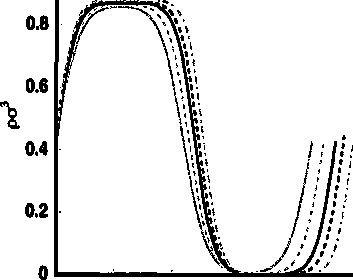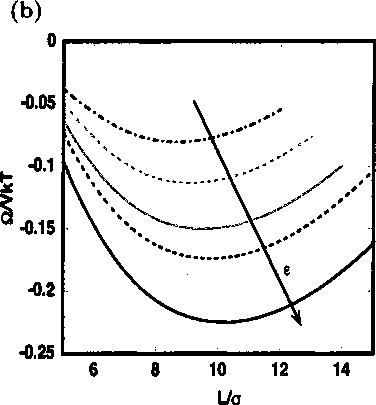1

О 2 4 6 8 10
z∕σ

Figure 5.3: (a) Equilibrium segment density profiles of the A block of the diblock copoly-
mer for e∕kT = 0.17 (solid gray curve, Db — 8.8σ), 0.2 (dashed gray curve, Db = 9.2σ),
0.231 (solid black curve, Db — 9.6σ), 0.25 (dashed black curve, Db =9.9 σ), and 0.289
(dot-dashed gray curve, Db = 10.2σ), and (b) grand free energy of the copolymer per unit
volume as a function of the width of the computational domain for e∕kT = 0.17 (dot-dashed
black curve), 0.2 (dashed gray curve), 0.231 (solid gray curve), 0.25 (dashed black curve),
and 0.289 (solid black curve). Number of segments in each of the blocks of the diblock
copolymer are 8.
to the fact that longer chains can stretch more in order to decrease the number of
contacts∕interfaces between the incompatible blocks. The bulk equilibrium period,
Db = 7.2σ, 8.4σ, 9.1σ, 11.0σ, and 11.6σ for N = 5, 6, 7, 9, and 10, respectively. The
experimental measurements of bulk lamellar spacing as a function of the copolymer
chain length at fixed χ have shown a power law dependence, Db oc N7. Modified
iSAFT calculations predict a value of 0.689 for γ from the slope of ln(D⅛) vs ln(N),
which is in agreement with the experimental data [152, 153, 154], strong segregation
theories (SST) [155, 156], SCFT [136, 157, 158] and Chandler, McCoy, and Singer
127
More intriguing information
1. El impacto espacial de las economías de aglomeración y su efecto sobre la estructura urbana.El caso de la industria en Barcelona, 1986-19962. A Note on Costly Sequential Search and Oligopoly Pricing (new title: Truly Costly Sequential Search and Oligopolistic Pricing,)
3. Education and Development: The Issues and the Evidence
4. On the job rotation problem
5. The Employment Impact of Differences in Dmand and Production
6. CAPACITAÇÃO GERENCIAL DE AGRICULTORES FAMILIARES: UMA PROPOSTA METODOLÓGICA DE EXTENSÃO RURAL
7. The name is absent
8. BEN CHOI & YANBING CHEN
9. Accurate, fast and stable denoising source separation algorithms
10. Effects of red light and loud noise on the rate at which monkeys sample the sensory environment